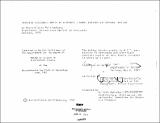Transfer passenger needs at airports : human factors in terminal design
Author(s)
Brillembourg, Marie-Claire
DownloadFull printable version (4.237Mb)
Other Contributors
Massachusetts Institute of Technology. Dept. of Architecture.
Advisor
Julian Beinart.
Terms of use
Metadata
Show full item recordAbstract
This thesis analyzes the needs of particular users of airport: transfer passengers. The object of this work has been to produce a set of design guidelines for terminals. these guidelines are framed upon a user-need survey conducted at Boston/Logan International Airport. The investigation has been organized around three important aspects: 1) how present airport terminal environments affect human behavior; 2) what are the physical characteristics and consequences of terminal design on transfer passengers; 3) how can a broader approach to the design of terminals with passengers in mind be applied. Current terminal design solutions have been "satisfactory" in terms of offering alternations for incoming and departing passengers. Very few terminals though, are prepared to cope with an increasing number of transfer passengers. This study clarifies passengers' characteristics and highlights those issues important for those who need to changed airplanes at an airport. These issues are: time involved in the transfer, means of arriving to the departing airline and the impact of the environment on the waiting passenger. the design guidelines presented as the conclusion of this study are an attempt to accommodate a set of behavioral variables to a system of physical variables. This environmental design approach is a continuing effort to include the user into the programming and design of projects.
Description
Thesis (M.S.)--Massachusetts Institute of Technology, Dept. of Architecture, 1982. MICROFICHE COPY AVAILABLE IN ARCHIVES AND ROTCH. Includes bibliographical references.
Date issued
1982Department
Massachusetts Institute of Technology. Department of ArchitecturePublisher
Massachusetts Institute of Technology
Keywords
Architecture.